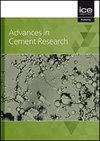大体积混凝土生产中使用液氮的低温冷却:温度分布、凝结时间和抗压强度
IF 1.3
4区 工程技术
Q3 CONSTRUCTION & BUILDING TECHNOLOGY
引用次数: 0
摘要
大体积混凝土结构中采用了多种混凝土混合物的冷却方法,以减少混凝土的热开裂,增强结构的完整性。在混凝土生产中,将水泥与水混合会产生水化热,这可能会导致混凝土混合物变干和开裂。试验工作旨在评估在冷却砂浆混合物和混凝土中使用液氮(LN)的效果。LN的用量为0、25、50、75和100%(按水体积计),用于在T=4°C下冷却混合水或将其直接注入混凝土混合物中。混凝土混合物的比例基于大体积混凝土的ACI PRC-207.1-21。对砂浆初凝和终凝时间和温度的测量表明,更多的LN%延迟了硬化过程,因此峰值硬化率出现较晚,表明水泥水化速度减慢。当VLN/Vwater≤1时,LN冷却可提高砂浆和混凝土立方体的抗压强度。然而,当VLN/Vwater>1时,由于冰晶的出现,混凝土抗压强度降低。用冷冻水冷却混凝土(T=4°C)显示,砂浆立方体的抗压强度增加了30%,当向混合物中注入LN时,抗压强度最大增加了16.45%。加入冷却水和LN后,混凝土抗压强度分别提高了34.51%和12.97%。与向混凝土混合物中注入LN相比,在冷冻水方法中,较慢的冷却过程促进了更好的水泥水化。本文章由计算机程序翻译,如有差异,请以英文原文为准。
Cryogenic cooling using liquid nitrogen in production of massive concrete: temperature profile, setting time and compressive strength
Various cooling methods of concrete mixtures are used in mass concrete structures to reduce concrete's thermal cracking and enhance the structures’ integrity. In concrete production, mixing cement with water is associated with hydration heat generation, which may cause concrete mixes to dry out and crack. The experimental work aims to evaluate the effects of using liquid nitrogen (LN) in cooling mortar mixes and concrete. LN was used in doses of 0, 25, 50, 75, and 100% by water volume to either cool the mixing water at T = 4 °C or to inject it into concrete mixtures directly. The proportions of concrete mixtures were based on ACI PRC-207.1-21 for mass concrete. Measurements of the mortars’ initial and final setting times and temperatures indicated that more LN% delayed the hardening process, so the peak hardening rates occurred later, exhibiting a slowdown of the cement hydration. LN cooling enhances the mortar and concrete cubes’ compressive strength when VLN/Vwater≤1. However, concrete compressive strength decreased due to the appearance of ice lenses that turn into voids when VLN/Vwater>1. Cooling concrete with chilled water (at T = 4°C) showed a 30% increase in the mortar cubes’ compressive strength and a maximum of 16.45% when injecting LN into the mixes. The concrete compressive strength increased by 34.51% and 12.97% when mixed with cooled water and injected LN into the mixtures, respectively. The slower cooling process promoted better cement hydration in the chilled water method compared to the injection of LN into the concrete mixture.
求助全文
通过发布文献求助,成功后即可免费获取论文全文。
去求助
来源期刊

Advances in Cement Research
工程技术-材料科学:综合
CiteScore
3.70
自引率
5.00%
发文量
56
审稿时长
3.2 months
期刊介绍:
Advances in Cement Research highlights the scientific ideas and innovations within the cutting-edge cement manufacture industry. It is a global journal with a scope encompassing cement manufacture and materials, properties and durability of cementitious materials and systems, hydration, interaction of cement with other materials, analysis and testing, special cements and applications.
 求助内容:
求助内容: 应助结果提醒方式:
应助结果提醒方式:


